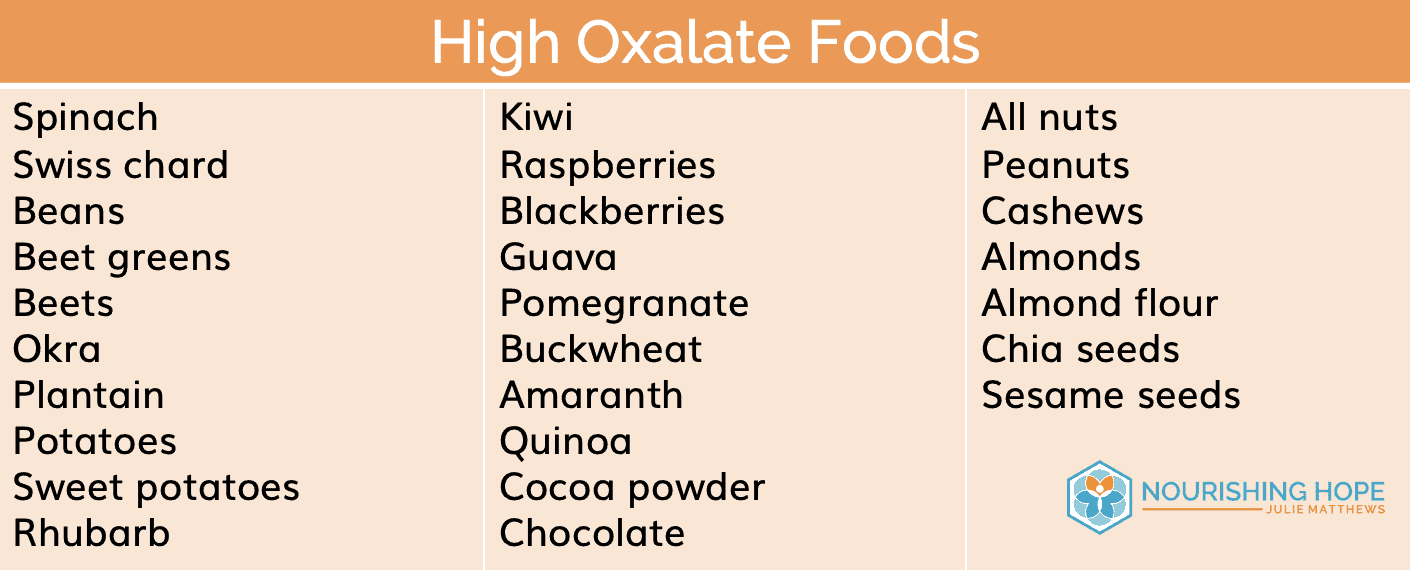Low Oxalate Diet
What are oxalates?
Oxalate is an antinutrient found in plants, where they have a number of functions, one of which is to deter animals from eating their leaves. They tend to be bound to calcium, so many high calcium foods, like spinach, are also high in oxalate.
High oxalate levels in the body can be a problem. Oxalates can lead to malnutrition, and can deposit throughout the body causing inflammation. Oxalates are most known for their role in creating kidney stones, however, the latest scientific research shows us even people without kidney stones can have problems with oxalates. Researchers found high oxalate levels in the individuals with autism, all who had normal kidney function.
Oxalates have been linked to:
- Inflammation (and activation of the inflammasome)
- Gastrointestinal issues
- microbiome imbalance
- Slow growth in children
- Pain
- Fatigue
- Brain fog
- Autoimmune disorders
- Chronic disease
- Autism
There are a number of reasons for high oxalates in the body. Normally, your gut microbiome deals with oxalates, but an imbalance in your gut bacteria and digestive disorders can lead to higher oxalate levels. Additionally, digestion of fats, vitamin and mineral levels, and individual biochemistry all affect oxalate levels.
Low Oxalate Diet
The low oxalate diet is designed to restrict the intake of high oxalate foods (not eradicate oxalates from the diet completely). Instead, the diet concentrates on limiting exposure where possible. The low oxalate diet is a helpful tool to use alongside diets like GFCFSF or SCD to fine-tune an individual’s diet.
Foods high in oxalate include: Spinach, swiss chard, nuts, some seeds, legumes, grains, certain fruits, beets, sweet potatoes, chocolate.

And the low oxalate diet can be helpful when oxalates are the cause of symptoms and underlying factors.
Also, be aware oxalates can also be produced inside the body (e.g. endogenously), so in addition to a low oxalate diet, other factors should be understood and considered such adequate levels of nutrients (such as B6), avoidance of certain supplements and foods that (while not high in oxalate) can convert to oxalate.
If you are considering a low oxalate diet, research oxalates, plan your approach before beginning, and go slowly. It’s important not to remove oxalates too quickly.
Explore our low oxalate diet recipes below. Be sure to read all of the instructions before beginning in case diet-compliant substitutions are described in the introduction.
Your child is unique and so are their diet and nutritional needs. Learn how personalized nutrition can help your child today. Download our guide: “12 Nutrition Steps to Better Health, Learning, and Behavior.”
Low Oxalate Diet Recipes
Non-Dairy “Buttercream” Frosting (Recipe)
Ingredients 1 2/3 cups powdered sugar ¼ tsp salt 1/3 cup palm shortening 1/3 cup non-dairy soy-free butter (such as Miyoko's Organic Vegan Butter) 1 ½ tsp vanilla 1 tsp - 1 Tbsp non-dairy milk Natural coloring (see below) Directions Cream shortening and non-dairy...
Squash Meatballs (Recipe)
SQUASH MEATBALLS (GFCF/SCD/LOD) From Cooking To Heal (Cookbook with DVD) by Julie Matthews To make SCD, use nut flour in place of GF breadcrumbs. For LOD and nut-free, use coconut flour. These can easily be made egg-free and grain-free (therefore SCD/GAPS, Paleo, AIP,...



